Peanuts: The peanut crop ranges from 90 days to digging. Dry weather is in the forecast and local growers are starting to irrigate again. Late leaf spot is being noticed in some fields. Foliage feeding caterpillar activity has been decreasing around the county.
Hull Scrape clinics will be held this week on Tuesday, Wednesday and Thursday from 8:30 to 10 am at the Colquitt County Extension office. If you need peanuts done at other times please call or txt me and we can arrange for those peanuts to be done. Last week, Georgia 06G were averaging 140 days in the samples that were brought to the office. There has been some variability in dryland samples as some fields have a split crop due to unique weather that we had this year.
Table 1 below reminds us that harvesting at the optimum time can make peanut growers money. This data, compiled by Monfort and Williams, shows that by digging a week early, growers can reduce yields by approximately 200 lbs, and digging a week late can result in a 600 lb yield reduction.

I have been seeing some late leaf spot in local peanut fields. Dr. Bob Kemerait, UGA Plant Pathologist, suggests that growers need to consider 1) what disease is in the field and 2) pre-harvest intervals. If only leaf spot is a concern, Alto (30-day PHI) + chlorothalonil works as well as Domark (14-day PHI) + chlorothalonil or Topsin (14-day PHI) + chlorothalonil. If white mold is a concern, teb and Fontelis can be used up until 14 days before harvest. Provysol-teb is also a good option if the disease hasn’t gone wild.
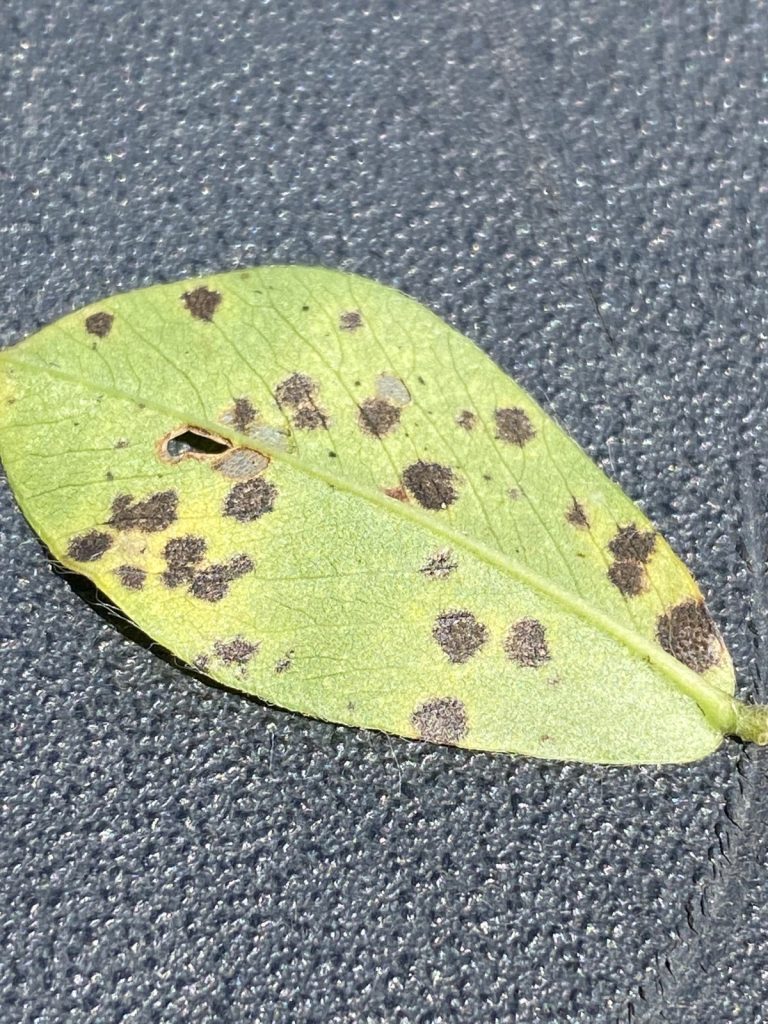
I have noticed plants in some fields crashing due to tomato spotted wilt. Diagnosis can be confusing because foliar symptoms can be found earlier in the season. The presence of a necrotic taproot is associated with spotted wilt.
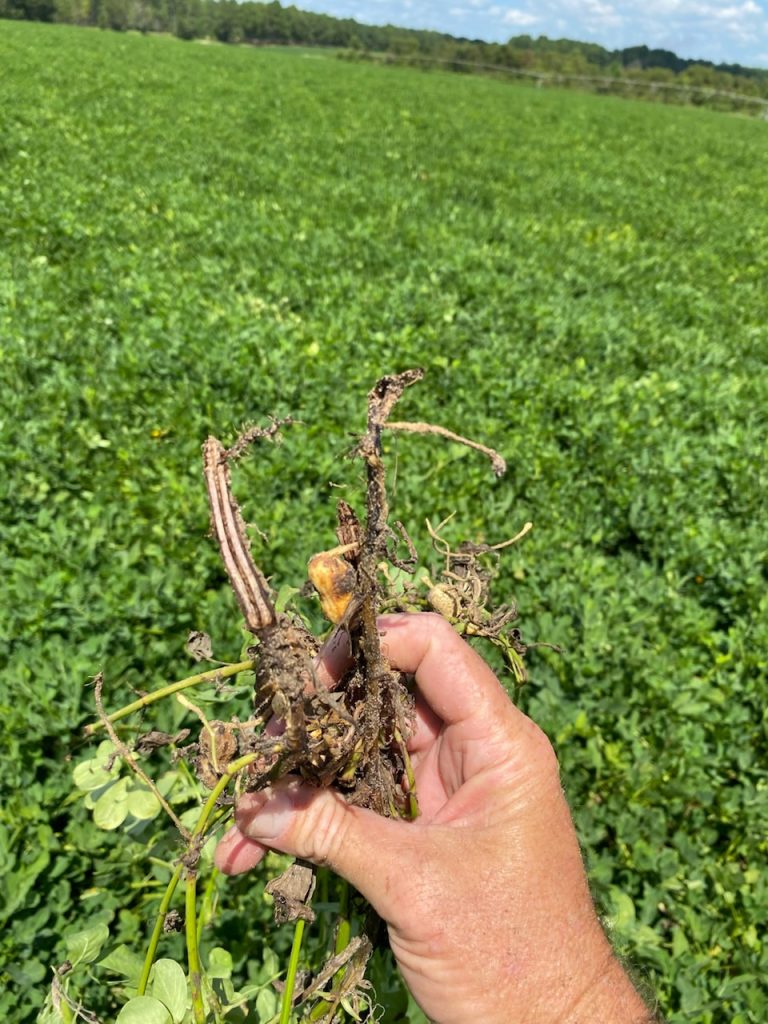
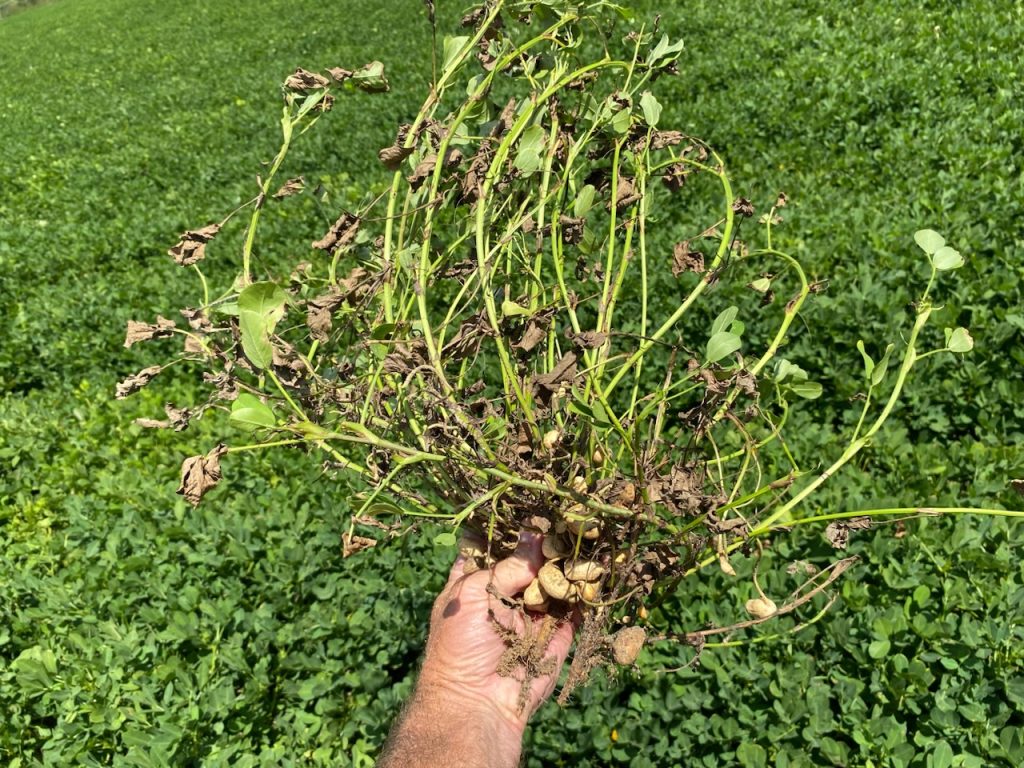
When to dig early? I had a question or two about disease pressure and how that influences when to dig peanuts. It is not recommended to dig early due to spotted wilt no matter how much is in the field. If white mold is reaching 50% then we need to consider digging. Leaf spot defoliation reaching 60% will likely result in yield loss.
The irrigation requirements for peanuts decline as we approach harvest. The table below shows the irrigation requirements for peanuts from weeks 16 to 22. The requirements drop from an inch a week at week 16 to zero at digging. The information is from the peanut section in last week’s blog post.

Cotton: The cotton crop ranges from 5 week of bloom to being defoliated. I have received numerous calls about red leaves in local cotton. Below is a good explanation of this and it is from the the September 2023 UGA Cotton Newsletter.
Some of the cotton leaves are turning red. In some cases this is just the plant showing its age and preparing for the end of the line. This is going to help us out come defoliation time. In other cases, as pictured below, we are seeing this where plants were blown around during the storm and the underside of the leaves is turning red in response to being exposed to the sun. Some other cases may be caused in response to the plant still being in waterlogged soils. Some of the cotton leaves are turning red. In some cases this is just the plant showing its age and preparing for the end of the line. This is going to help us out come defoliation time. In other cases, as pictured below, we are seeing this where plants were blown around during the storm and the underside of the leaves is turning red in response to being exposed to the sun. Some other cases may be caused in response to the plant still being in waterlogged soils.
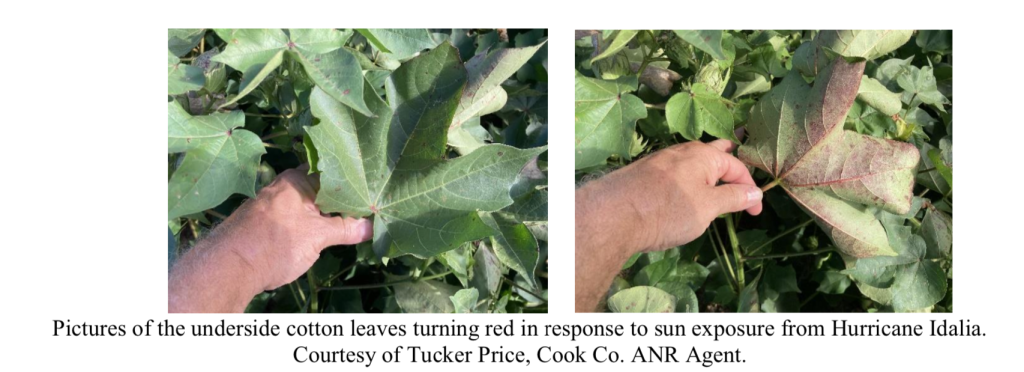
What about irrigation on my cotton? Common question this week was how much water to apply. Below is part of article in the September 2023 edition of the UGA Cotton Newsletter called Importance of End of Season Irrigation Termination and Disease Control in Cotton (Bob Kemerait, Wes Porter, David Hall, Jason Mallard, Phillip Edwards and Daniel Lyon):
As water use declines, it is necessary to closely monitor your fields for cotton bolls that are beginning to open. UGA’s official irrigation termination recommendation for cotton is at an average of 10% open boll across a field. When you consider the math, 10% open is not a high number of bolls on a plant that are open to start considering irrigation termination. A plant with 12 to 15 harvestable bolls means you need to be looking at the available soil moisture if 1.2 to 1.5 bolls are open. September 2019 was an anomaly that was hot and dry. Bolls were beginning to open but our available water in the soil was depleted very rapidly due to the environmental conditions. Due to dry soils, hot temps and long-term dry weather forecasts, one last irrigation event(s) was(were) needed to help finish the crop. The low humidity and sunny conditions helped to prevent open bolls from being damaged. Do not self-inflict or worsen boll rot issues if sufficient soil moisture is present. In times when an application of irrigation is needed, soak the soil sufficiently so that you can limit your irrigation events to as few as possible. Frequent small irrigation events will only exacerbate or flare boll rot, areolate mildew and other diseases. Paying attention to the long term and short-term forecast is critical in your irrigation scheduling decisions as always. The tropics have a way of surprising us with pop up storms or even hurricanes this time of year.
Keep in mind, good moisture in the soil and 10% open bolls means the end of another irrigation cotton season!
An updated value by boll positioning chart was produced by Whitaker (2019) showing the importance of those lower and first position bolls.

This boll value tree really emphasizes the importance of first setting those high dollar bolls early in the season with proper management. Nearing the end of the growing season, overwatering and irrigating your crop with a higher than 10% open boll in an effort to make young upper position low value bolls open in the top will lead to losing or damaging your most valuable bolls and reducing yield and profitability. Not to mention, those young bolls probably will not mature enough to be harvested anyway. If you have questions about finalizing irrigation make sure you reach out to your local UGA County Extension Agent.
You can always tell when the harvest season is rapidly approaching when cotton fields start to open and questions about defoliation become common. There are three main methods of determining defoliation. One method is to defoliate when the crop reaches 60 to 75% open bolls (only 60 for a uniform crop). The crop in question has to be very uniform for this method to work. Another method discussed is using a sharp knife or a pipe cutter to cut the bolls. Growers can evaluate maturity when the cotton strings out and the seed is fully developed (brown coat and cotyledons as the boll is cut). The third method is when nodes above cracked boll (NACB) are 4 or less (around 3 days per node). There is often a relationship between the percent of open bolls in the canopy and the number of nodes between the uppermost first-position cracked boll and the uppermost first-position harvestable boll (NACB).
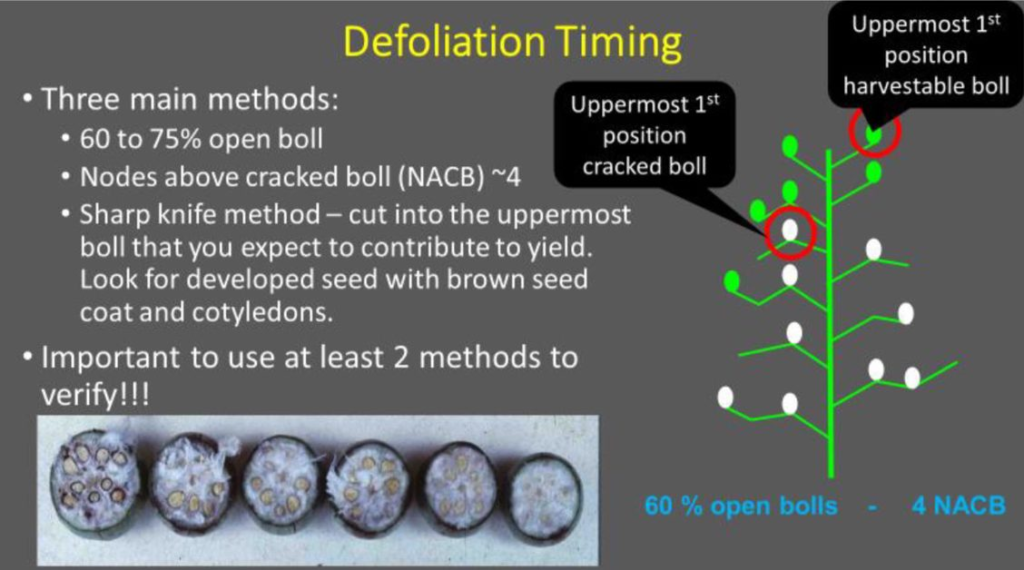
Mr. Kichler, what are the three way rates for defoliation? I am glad you asked and they are included in the table below.
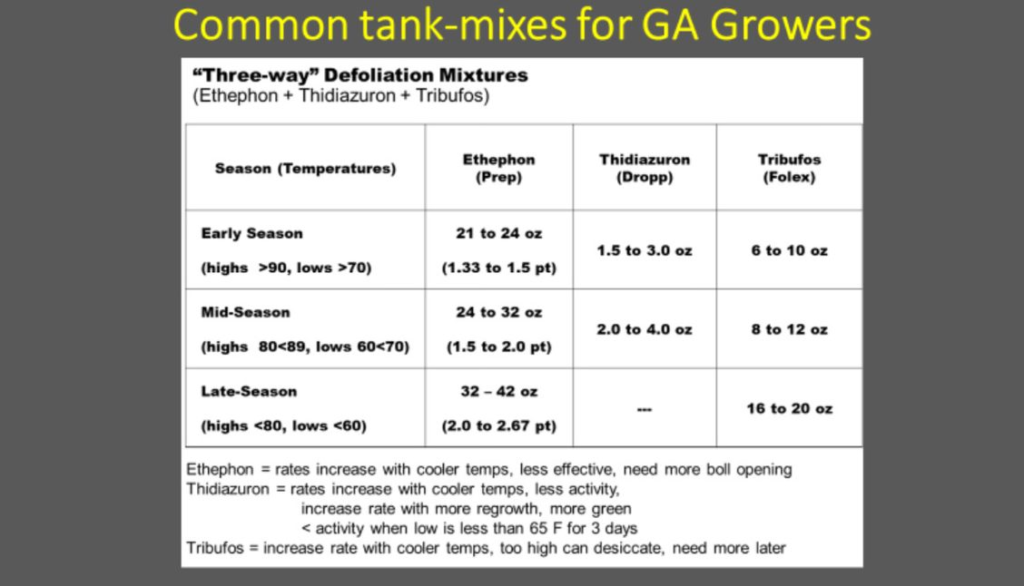
Mr. Jeremy, there was information last week about winter annual forage variety recommendations. Do you have any information on grain varieties? Yes, the UGA OVT has released information about recommended varieties for barley, triticale, oats, and wheat. If you would like to evaluate yield data from OVT, it can be obtained here. When selecting small grain varieties, gather information on disease packages, vernalization requirements, and other agronomic characteristics to determine if they are a fit for your farm.
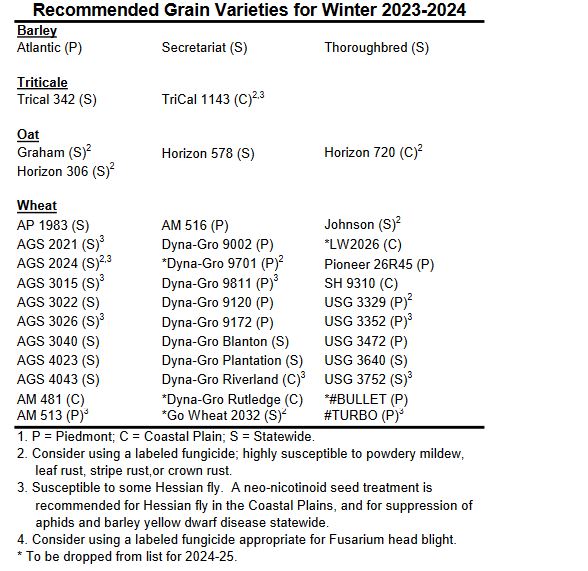
Have a great week and if you have questions please let me know.
Jeremy M. Kichler
Colquitt County Extension Coordinator
The University of Georgia Cooperative Extension does not endorse or guarantee the performance of any products mentioned in this update.
